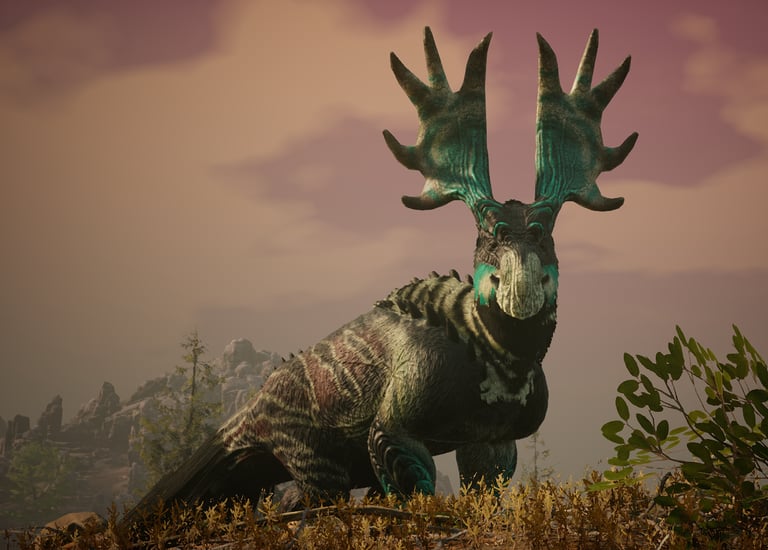Cerataspida (Fluff)
REALMS
7/30/2024
Tier Two: Humongous
Tag(s): Adopts
Group Limit: Cerataspida-Only Herd: 3 sub/adult males, 3 sub/adult females, their offspring
Mix-Packed Herbivore Herd: 1 sub/adult male, 1 sub/adult female, their offspring
Nesting Season: Wet season- 3 eggs
Independent Stage: Sub-Adult
SOCIAL BEHAVIOR (OPTIONAL):
Like socializing with other Citipati and will dance or mimic each other to play
Flocks are communal and will watch over offspring together
SEXUAL DIMORPHISM:
Males typically have larger horns and more fur than females.
Males can have more vibrant colors but this isn’t the most distinguishing feature between males and females
NOTES:
N/A
SPECIES BIO:
General: The Cerataspida is a large herbivore that rivals the strength of even some of the most fearsome carnivores in the realms. Enormous horns on its head to gore with, impressive arms for landing heavy blows, and powerful hind legs for kicking and keeping pace with apexes, this is an animal not to be taken lightly. A very capable herbivore indeed which makes it all the more surprising that it is relatively docile. But if provoked in some way it will not hesitate to beat the culprit down until it doesn’t get back up.
Lifespan: Cerataspida are born pretty uncoordinated and spend some time learning how to walk. Since their strength isn’t built up yet they tend to walk on all fours until they feel strong enough to stand on two. During this time they will stick close to their parents for protection and follow them to learn what is safe to eat. Juveniles and Adolescents become much more rambunctious much to their parent’s dismay. Marking every tree they come across with marks from their antlers or their punches. During this stage of their life they learn how to really use their defenses from watching their parents. Sub-adults leave the care of their parents and herd and venture out on their own either to find a mate or join another herd.
Courtship and Parenthood: Cerataspida courting is pretty straight forward; The strongest males get the most attention. This either means that the antlers and sheer size of a male will put off other males from attempting to steal a potential female, but sometimes it isn’t enough. If it isn’t then a “boxing” match may occur between the two males until one either backs down or dies. These are very brutal fights and so it is important that males always be alert and careful to be ready for them. Females don’t pay attention to the losers usually, but if they find a male too dangerous for potential offspring then she may shoo him away regardless if he won or not.
Both the male and females of this species are nurturing parents in their own way. Females are more gentle with the offspring and likes to fawn over her young. The males are more rowdy, roughhousing with his offspring sometimes even playing dead to act as if his offspring beat him. This rough housing sometimes gets the female to tell off the male though if she believes it is going too far. Both parents are protective though and any predator should beware Cerataspida parents because both will go from docile parents to raging behemoths in a flip of a switch.
Social Behavior: Herds consisting of Cerataspida are few and far between as their attitude towards members of their own species is quite different than their behavior towards other species. Their normal docile attitude turns into a confrontational one with each other and fights can break out between herd members for food, water, personal space, mating rights, even a place to sleep! Males and females both share this trait and so herds consisting of anything more than a mated pair and their offspring is rare. Cerataspida are better herd mates to other species of herbivores though which raises a myriad of questions, but none have been answered as of now.




